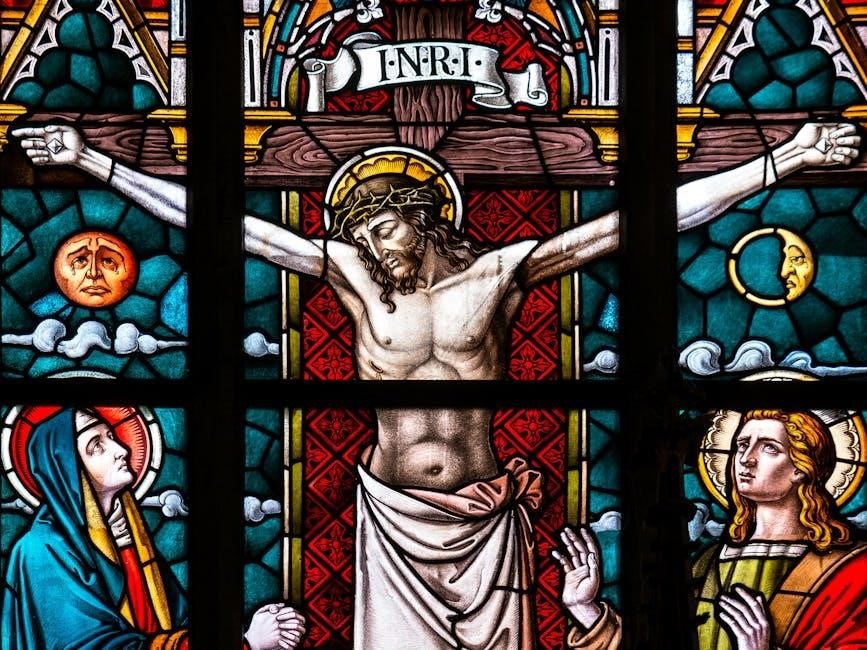What is Eucharistic Adoration?
Eucharistic Adoration is a sacred practice where the faithful pray before the Blessed Sacrament, often exposed in a monstrance, fostering deep spiritual connection and reverence․
Eucharistic Adoration is a sacred Catholic practice where the Blessed Sacrament, the Eucharist, is reverently exposed in a monstrance for worship and prayer․ This devotion involves taking the consecrated Host from the tabernacle and displaying it for the faithful to adore․ The Adoration Guide PDF outlines the Rite of Eucharistic Exposition and Benediction, providing a structured approach to this profound act of worship․ It emphasizes prayer, reflection, and spiritual connection with Christ’s real presence in the Eucharist, fostering a deeper relationship with God․
The Significance of Eucharistic Adoration in Catholic Worship
Eucharistic Adoration holds profound significance in Catholic worship, emphasizing the Real Presence of Jesus Christ in the Eucharist․ It deepens devotion, fosters spiritual growth, and strengthens communion with God․ The Adoration Guide PDF highlights its role in nurturing faith, unity, and personal transformation․ By reverencing the Blessed Sacrament, believers encounter Christ’s love and mercy, finding peace and guidance․ This sacred practice is a cornerstone of Catholic spirituality, inviting all to worship, reflect, and draw closer to the divine presence in their lives․

History and Origins of Eucharistic Adoration
The practice of Eucharistic Adoration traces back to early Christianity, evolving over centuries․ The Adoration Guide PDF explores its roots in the Last Supper and apostolic traditions, highlighting its growth through medieval devotion and liturgical developments, becoming a central act of worship in the Catholic Church․
Early Christian Practices of Adoration
The roots of Eucharistic Adoration are found in the apostolic tradition, where the Eucharist was revered as the real presence of Christ; The early Church reserved the Eucharist for the sick and the absent, fostering a deep devotion․ By the fourth century, adoration practices began to emerge, with Christians praying before the Blessed Sacrament․ The Adoration Guide PDF highlights how these early practices laid the foundation for formal Eucharistic adoration, emphasizing the Eucharist’s central role in worship and spiritual life․
The Development of Eucharistic Exposition and Benediction
Eucharistic Exposition and Benediction emerged as formal practices in the Middle Ages, gaining prominence by the 16th century․ The Council of Trent encouraged devotion to the Blessed Sacrament, leading to structured rituals․ Exposition involved displaying the Eucharist in a monstrance, while Benediction concluded with a blessing․ The Adoration Guide PDF outlines how these practices deepened reverence for the Eucharist, fostering a devotional movement that remains central to Catholic worship, emphasizing Christ’s real presence and divine love․

How to Participate in Eucharistic Adoration
Participating in Eucharistic Adoration involves entering reverently, spending quiet time in prayer, and focusing on Christ’s presence․ It deepens spiritual connection and fosters inner peace․
Preparing for Adoration: Spiritual Readiness
Preparing for Eucharistic Adoration involves spiritual readiness through prayer, reflection, and sacramental confession․ Begin by examining your heart, seeking forgiveness, and cultivating a desire to encounter Christ․
Read Scripture or spiritual writings to focus your mind and soul․ Arrive early to quiet your spirit, and avoid distractions by setting aside worldly concerns․ Approach with reverence, recognizing the sacredness of the moment․ Spiritual preparation ensures a deeper, more meaningful experience of adoration and communion with the Blessed Sacrament․
Prayers and Reflections During Adoration
During Eucharistic Adoration, engage in heartfelt prayers and reflections to deepen your connection with Christ․ Recite traditional prayers like the Our Father, Hail Mary, or the Litany of the Sacred Heart․ Reflect on Scripture passages, especially those highlighting Jesus’ love and sacrifice․ Spend time in silence, listening to God’s voice, and offer personal intentions․ You can also journal your thoughts or sing hymns of praise․ This sacred time fosters intimacy with the Eucharistic Lord, renewing your spirit and drawing you closer to His divine love․
Etiquette and Proper Behavior in the Presence of the Blessed Sacrament
When in the presence of the Blessed Sacrament, maintain reverence and respect․ Genuflect upon entering and exiting the adoration chapel․ Dress modestly and avoid distractions․ Keep silence or speak softly to foster prayerful contemplation․ Refrain from unnecessary movement and avoid using electronic devices․ Keep your hands folded or clasped in prayer․ Bow your head when the monstrance is passed or during benediction․ These practices honor the sacredness of the Eucharist and promote a spirit of communal worship․

The Role of the Monstrance in Adoration
The monstrance holds the Blessed Sacrament, showcasing the Eucharist for adoration․ Its glass or crystal design allows the faithful to contemplate the sacred Host, fostering deeper worship and devotion․
Understanding the Monstrance and Its Symbolism
The monstrance is a sacred vessel used to display the Blessed Sacrament during Eucharistic Adoration․ Its design often features a cross and rays, symbolizing Christ’s sacrifice and divine light․ The glass or crystal center allows the faithful to gaze upon the Host, emphasizing the Real Presence of Jesus․ The monstrance’s elevation on the altar signifies the central place of the Eucharist in Catholic worship, drawing believers into profound reverence and spiritual communion with God․
The Process of Exposing the Blessed Sacrament
Exposing the Blessed Sacrament involves a solemn ritual where the priest removes the consecrated Host from the tabernacle and places it in the monstrance․ The priest then incenses the Sacrament, symbolizing reverence and purification․ The monstrance is placed on the altar, surrounded by candles, and the congregation kneels in adoration․ This sacred act signifies the Real Presence of Christ, inviting the faithful to worship and deepen their communion with Him through prayer and contemplation․
The Liturgy of the Hours and Adoration
The Liturgy of the Hours enriches Eucharistic Adoration by weaving prayer, psalms, and Scripture into a sacred rhythm, deepening devotion and uniting the faithful in worship․
Praying the Psalms During Adoration
Praying the Psalms during Eucharistic Adoration connects worshippers to ancient expressions of praise, thanksgiving, and repentance․ The Psalms, inspired by the Holy Spirit, mirror the emotions of the heart, making them ideal for adoration․ Reciting Psalms like 23, 51, or 103 fosters a deeper union with Christ, allowing the soul to resonate with divine love․ This sacred practice bridges the earthly and heavenly, drawing believers into the Eucharistic presence with humility and devotion, enriching their spiritual encounter․
Integrating the Liturgy of the Hours into Adoration Practices
Integrating the Liturgy of the Hours into Eucharistic Adoration enriches prayer by aligning it with the Church’s universal rhythm․ The Hours, comprising prayers, psalms, and readings, deepen devotion and foster a sense of community․ Incorporating Morning Prayer, Evening Prayer, or Night Prayer during adoration creates a structured yet flexible framework for worship․ This practice not only enhances personal prayer life but also unites adorers with the global Church, emphasizing the beauty of communal devotion while contemplating the Blessed Sacrament․

Prayers for Eucharistic Adoration
Eucharistic adoration is enriched with traditional prayers, such as the Anima Christi and Ave Verum Corpus, fostering devotion and intimacy with the Blessed Sacrament․
Traditional Prayers and Hymns for Adoration
Traditional prayers like the Anima Christi and Ave Verum Corpus are essential in Eucharistic adoration, expressing deep reverence for the Blessed Sacrament․ Hymns such as O Salutaris Hostia and Adoro Te Devote enrich the experience, fostering a spirit of worship and contemplation․ These timeless prayers and hymns, rooted in Catholic tradition, guide believers in expressing their devotion and love for Christ’s real presence in the Eucharist, making adoration a profound encounter with the divine․
Writing Personal Prayers for Adoration
Writing personal prayers for adoration allows for a deeply intimate and heartfelt conversation with Christ․ Begin by expressing your love and gratitude for His real presence in the Eucharist․ Share your joys, struggles, and intentions, asking for guidance and healing․ Use Scripture or reflections to inspire your words․ You can also pray for others, seeking blessings and mercy․ Keep your prayer simple, sincere, and focused on Him․ This personal dialogue strengthens your relationship with the Lord and deepens your adoration experience․

The Role of the Tabernacle in Adoration
The tabernacle serves as a sacred sanctuary for the Blessed Sacrament, symbolizing God’s eternal presence among His people․ It is a focal point of reverence and prayer during adoration, reminding the faithful of Christ’s abiding love and sacrifice․ The tabernacle’s solemn presence invites deep devotion and humility, fostering a profound connection with the Eucharistic Lord․
Understanding the Tabernacle as a Symbol of God’s Presence
The tabernacle is a profound symbol of God’s enduring presence among His people, embodying the Real Presence of Christ in the Eucharist․ It stands as a sacred dwelling place, reminiscent of the Ark of the Covenant, where God’s glory resided․ The tabernacle’s design often reflects divine majesty, inspiring reverence and awe․ By housing the Blessed Sacrament, it signifies God’s intimate closeness, inviting believers to encounter His love silently yet powerfully․ This sacred vessel fosters a deep sense of divine intimacy and unwavering faith․
Visiting the Tabernacle Outside of Formal Adoration
Visiting the tabernacle outside of formal adoration offers a unique opportunity for personal prayer and reflection․ It allows believers to connect with the Real Presence of Christ in a quiet, intimate setting․ Many find solace in these moments, seeking guidance, comfort, or simply expressing gratitude․ This practice fosters a deeper intimacy with God and complements formal adoration by encouraging a consistent, personal relationship with Him․ Every visit, no matter how brief, enriches one’s spiritual life and strengthens faith․

Benefits of Eucharistic Adoration
Eucharistic adoration enriches spiritual growth, deepens faith, and fosters a personal connection with Christ, offering healing, peace, and a sense of community among believers․
Spiritual Growth and Deepening Faith
Eucharistic adoration fosters profound spiritual growth by drawing believers into a deeper, personal encounter with Christ․ Through quiet reflection and prayer, adorers experience a renewed sense of purpose and intimacy with God․ Regular adoration cultivates humility, surrender, and a greater appreciation for the sacraments․ It also deepens biblical understanding and devotion, helping individuals discern God’s will and live a life of faith․ Many find that adoration strengthens their commitment to prayer, service, and living as disciples of Christ in everyday life․
Healing and Intercession Through Adoration
Eucharistic adoration is a powerful means of seeking healing and interceding for others․ Many believers bring prayer intentions to adoration, entrusting them to Christ’s presence․ The Blessed Sacrament is seen as a source of divine mercy and grace, offering comfort to the afflicted․ Adorers often pray for physical, emotional, or spiritual healing, both for themselves and others․ This sacred time fosters a deep reliance on God’s providence and trust in His loving plan, bringing solace and renewal to all who participate․
Building Community Through Shared Adoration
Shared Eucharistic adoration fosters a sense of unity and belonging among believers․ Gathering together to worship Christ in the Blessed Sacrament strengthens bonds within the faith community․ This collective prayer experience creates an environment of mutual support and encouragement․ Participants often feel a deeper connection to one another, united by their devotion and shared faith․ Such communal adoration not only enriches individual spirituality but also nurtures a vibrant, cohesive parish life, where believers inspire and uplift each other in their walk with God․
Resources for Eucharistic Adoration
Discover a wealth of resources, including PDF guides, books, and online materials, to deepen your understanding and prayer life during Eucharistic adoration․
Recommended Books and Guides on Adoration
Enhance your adoration experience with inspiring books and guides, such as The Lamb’s Supper by Scott Hahn, which explores the Eucharist’s connection to heavenly worship․ In Sinu Jesu, a spiritual guide by an anonymous author, offers profound reflections for adorers․ Additionally, downloadable PDF guides like The Adoration Handbook provide practical prayers and meditations․ These resources deepen devotion, fostering a richer spiritual encounter with the Blessed Sacrament and inspiring a life of faith and love․
Online Resources and PDF Guides for Adoration
Discover a wealth of online resources and PDF guides to enrich your adoration experience․ Websites like EWTN and CatholicMom offer downloadable prayer guides and reflections․ PDFs such as The Adoration Guide provide structured prayers and meditations․ Mobile apps like iPieta and Laudate offer digital access to adoration resources․ These tools help deepen your devotion, whether at home or in a chapel, fostering a spirit of prayer and intimacy with the Eucharist․

Personal Stories and Testimonies of Adoration
Personal stories and testimonies reveal how adoration guides in PDF formats have inspired faith journeys, fostering peace and spiritual growth through Eucharistic devotion․
Inspiring Stories of Faith Through Adoration
Many individuals have shared profound experiences of faith renewal through Eucharistic adoration․ These stories highlight how adoration guides, often in PDF formats, have helped deepen their devotion and prayer life․
Some recount moments of healing, clarity, and spiritual awakening during adoration․ These testimonies serve as reminders of the transformative power of spending time with the Blessed Sacrament, fostering a deeper connection with Christ․
How Adoration Has Transformed Lives
Eucharistic adoration has profoundly impacted countless lives, fostering spiritual renewal and a deeper connection with God․ Many have found peace, strength, and clarity through regular adoration, often guided by resources like adoration guide PDFs․ These guides provide structured prayers and reflections, helping individuals make the most of their time in adoration․ Stories of healing, inspiration, and faith growth highlight the transformative power of adoration, making it a cornerstone of many believers’ spiritual journeys․
The Role of Saints in Eucharistic Adoration
Saints have long been ardent promoters of Eucharistic adoration, inspiring believers through their devotion and writings, as highlighted in many adoration guide PDFs available today․
St․ John Vianney and His Devotion to the Eucharist
St․ John Vianney, the patron saint of parish priests, was deeply devoted to the Eucharist, spending hours in adoration․ His unwavering belief in the Real Presence transformed his ministry, inspiring countless souls to embrace adoration․ In adoration guide PDFs, his teachings emphasize the Eucharist as the heart of priestly and lay devotion․ His example shows how adoration fosters intimacy with God, leading to spiritual renewal and a life of service․ His legacy continues to inspire modern Catholics to deepen their prayer life through Eucharistic adoration․
Other Saints and Their Contributions to Eucharistic Adoration
St․ Margaret Mary Alacoque promoted the Sacred Heart devotion, fostering Eucharistic adoration as a central practice․ St․ Clare of Assisi miraculously protected the Eucharist, emphasizing its sanctity․ St․ Thomas Aquinas composed hymns like Tantum Ergo, enriching adoration liturgies․ These saints, along with others, have deepened the Church’s reverence for the Blessed Sacrament․ Their lives and writings inspire Catholics to embrace adoration as a powerful means of spiritual growth and worship, highlighting its timeless significance in Catholic tradition․

How to Lead Others in Eucharistic Adoration
- Prepare spiritually through prayer and reflection to set a reverent tone․
- Guided prayers and readings to foster deeper devotion․
- Encourage silent reflection and personal prayer․
- Conclude with a blessing or hymn to unite the group․
Organizing Adoration Services in Your Parish
Organizing Eucharistic Adoration services involves careful planning and coordination with parish leadership․ Begin by forming a committee to oversee logistics, such as scheduling, promotions, and volunteer coordination․ Choose a date and time that maximizes participation, ensuring the Blessed Sacrament is exposed by an ordained minister․ Create a worship aid with prayers and hymns, and promote the event through bulletins, social media, and announcements․ Encourage attendees to sign up for specific time slots to ensure continuous adoration․ Provide a reverent atmosphere with appropriate lighting and seating․ Offer resources like prayer guides or reflections to deepen the experience․ Follow diocesan guidelines for exposition and benediction, ensuring safety and reverence throughout the event․ Encourage parishioners to invite others, fostering a sense of community and shared devotion․ Regularly evaluate and improve the process to sustain meaningful adoration practices․
Training Others to Lead Adoration
Training others to lead Eucharistic Adoration requires equipping them with foundational knowledge and practical skills․ Begin by explaining the significance of adoration and its role in Catholic worship․ Demonstrate how to prepare the sacred space, handle the monstrance, and lead prayers․ Emphasize the importance of reverence and proper etiquette․ Encourage them to study the prayers and hymns used during adoration․ Provide opportunities for them to shadow experienced leaders and offer constructive feedback․ Ensure they understand the spiritual and liturgical aspects of adoration to lead confidently and effectively․
Music and Adoration
Music enhances Eucharistic Adoration by creating a sacred atmosphere, fostering devotion, and deepening prayer․ Traditional hymns and chants, such as Tantum Ergo, honor the Eucharist, while contemporary songs can inspire modern worshippers․
Traditional Hymns and Chants for Adoration
Traditional hymns and chants, such as Tantum Ergo and Adoro Te Devote, are sacred expressions of Eucharistic devotion․ These ancient melodies, often in Latin, evoke a profound sense of reverence and awe․ They are rooted in centuries of Catholic liturgical tradition, drawing worshippers into a deeper spiritual encounter․ The hymns’ theological richness and meditative rhythms create an atmosphere conducive to prayer and contemplation, helping the faithful connect with the Real Presence in the Blessed Sacrament․
Contemporary Music in Eucharistic Adoration
Contemporary music enriches Eucharistic adoration by blending modern melodies with timeless devotion․ Instruments like acoustic guitars and pianos create a gentle, intimate atmosphere, fostering personal prayer․ Simple, repetitive refrains, such as O Lord, I Lift Your Name on High or What a Beautiful Name, help focus minds and hearts on Christ’s presence․ This style appeals to younger generations while maintaining reverence, offering a fresh yet profound way to express love and adoration for the Blessed Sacrament․

Common Challenges in Eucharistic Adoration
Distractions, dryness, and maintaining focus are common challenges during adoration․ Overcoming these requires intentional prayer, discipline, and trusting in God’s presence, even when feelings fade․
Overcoming Distractions During Adoration
Distractions are common during adoration, but they can be managed by focusing on the present moment and Jesus’ Real Presence․ Acknowledge distractions gently without frustration, then refocus on prayer or scripture․ Using a rosary, prayer book, or hymns can help maintain concentration․ Cultivating mindfulness and surrendering distractions to God transforms them into opportunities for growth․ Remember, even saints faced distractions; perseverance and patience are key to deepening your adoration experience and fostering a deeper connection with Christ․
Staying Focused and Engaged in Prayer
To stay focused during adoration, begin by setting clear intentions to encounter Christ․ Use prayer aids like the rosary or sacred hymns to maintain devotion․ Practice mindfulness by grounding yourself in the present moment, acknowledging God’s presence․ Reflect on scripture or spiritual readings to deepen engagement․ Maintain reverent posture, such as kneeling, to foster concentration․ Persistence is key; even if your mind wanders, gently refocus on the Blessed Sacrament․ Over time, these practices will help you cultivate a deeper, more meaningful prayer life․
FAQs About Eucharistic Adoration
Common Questions About Adoration Practices
What is Eucharistic Adoration? It is the worship of Jesus Christ present in the Eucharist, where believers adore, pray, and seek spiritual transformation․
Is Adoration only for Catholics? No, all Christians are welcome to participate, though it holds special significance in Catholic tradition․
Can I adore if I’m not fasting? Yes, but fasting is traditionally encouraged before receiving the Eucharist, not necessarily for adoration․
How long should I stay? There’s no set time; even brief visits can be meaningful, but many spend 30 minutes to an hour․
Can children participate? Absolutely; it’s a beautiful way to teach them about Christ’s Real Presence․
What is Eucharistic Adoration? It is the act of worshiping Jesus Christ present in the Eucharist, believing in His Real Presence․
What do I do during Adoration? Pray, reflect, read Scripture, or simply sit in silent reverence before the Blessed Sacrament․
Is Adoration the same as Mass? No, Adoration focuses on worshiping the Eucharist outside of the Mass․
Can non-Catholics participate? Yes, all are welcome to pray and experience the sacredness of the moment․
What if I’m unfamiliar with the prayers? Guides and resources, like an adoration guide PDF, can help you navigate the experience․
Misconceptions About Eucharistic Adoration
Some believe Eucharistic adoration is only for the deeply spiritual or requires hours of prayer․ Others think it is boring or unnecessary․ However, these are misunderstandings․ Adoration is accessible to all, regardless of spiritual maturity, and even short visits can be fruitful․ It is not about prolonged prayer but being present with Christ․ Many also mistakenly believe adoration is a solitary act, yet it strengthens community bonds․ These misconceptions often deter people from experiencing the transformative power of adoration․
The Importance of Eucharistic Adoration in Modern Christianity
Eucharistic Adoration holds profound significance in modern Christianity, offering a timeless opportunity for believers to deepen their intimacy with God․ In a world filled with distractions, adoration provides solace, fostering spiritual renewal and a stronger connection to the Eucharist․ It strengthens faith, nurtures prayerful reflection, and invites Christians to encounter Christ’s real presence․ By prioritizing adoration, the Church revitalizes its mission, inspiring believers to live as witnesses of God’s love in their daily lives, ensuring the Eucharist remains at the heart of Christian devotion․
A Call to Action: Embracing Adoration in Your Spiritual Life
Embrace Eucharistic Adoration as a transformative practice in your spiritual journey․ Set aside time to adore the Blessed Sacrament, allowing God’s presence to fill your heart․ Whether in silence or with prayer, adoration deepens your relationship with Christ․ Invite others to join you, fostering a community of faith․ Start small, even with brief visits, and let the grace of adoration guide you toward spiritual renewal․ Make adoration a cornerstone of your prayer life and experience the profound love of God․
